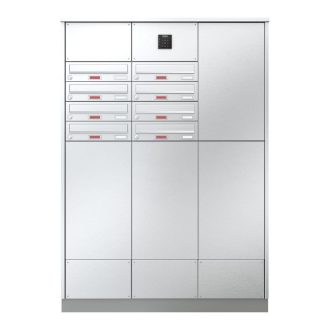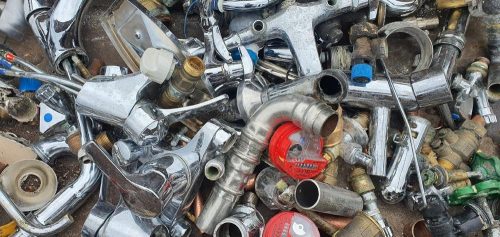Challenging framework conditions for combined transport
Traffic development 2023
Last year, the Hupac Group transported around 975,000 road consignments or 1,866,000 TEU in combined road/rail and maritime hinterland transport. This represents a decrease of about 130,000 consignments or 11.7% compared to the previous year. All transport segments of Hupac’s Europe-wide network were affected by this negative development, albeit to varying degrees. In the core market of transalpine transport through Switzerland, Hupac recorded a comparatively moderate decline of 7.6% to 540,000 road consignments.
This negative development is mainly due to the declining demand for transport in Europe. The recessionary trend started in the autumn of 2022 in connection with the Ukraine and the energy crisis and affected large parts of the world economy in the course of 2023.
Rail infrastructure bottleneck
To make matters worse, a number of factors are putting increasing pressure on the rail system. First and foremost is the poor quality of the rail network, especially in Germany, due to neglected maintenance and inadequate national and international construction planning. Capacity bottlenecks, delays and cancellations are the order of the day on many corridors. The serious accident in the Gotthard base tunnel in August was an additional exceptional factor. The complete closure of one of the two tunnel tubes until September 2024 significantly reduces the capacity of the line. "Fortunately, the impact on rail freight transport is limited, as good solutions have been found together with SBB," says Michail Stahlhut, CEO of the Hupac Group. "We expect that the forthcoming necessary general overhaul of the German rail network will be organised in a market-compatible manner so as not to nip the politically desired turnaround in transport in the bud."
Rising rail costs, falling subsidies in Germany
The massive double-digit cost increases in the rail system are also counterproductive. High track and traction costs are out of all proportion to the service provided. "We must do everything we can to stop the trend of shifting traffic back from rail to road," Stahlhut demands. Instead, the system is being deprived of the support it urgently needs, especially in times of crisis. The current, unplanned significant reduction in track access charge subsidies in Germany is worsening the framework conditions for combined transport and, given the current margin situation, will inevitably lead to the additional costs being passed on to the market.
Concrete measures for modal shift in Switzerland
On the other hand, the Swiss Federal Office of Transport’s subsidy policy is to be viewed positively. The support measures are stable and therefore have an anti-cyclical effect, which creates confidence and supports the market in the long term. This makes it all the more important to continue to support transalpine combined transport in the coming years. "The planned focus on short-distance transalpine transport from southern Germany and Switzerland must not be at the expense of other segments," demands Hans-Jörg Bertschi, chairman of the Board of Directors of Hupac. Long-distance transport in particular is threatened by reverse modal shift due to the tense performance conditions and should continue to be supported.
Infrastructure measures to ensure capacity and stability on the north-south corridor are just as important as market-oriented financing. "The Lauterbourg-Strasbourg-Basel and Antwerp-Metz-Basel routes are crucial for further progress in modal shift: they represent an alternative to the Rhine Valley railway and should be developed as a priority for freight transport," says Bertschi. Smaller measures, such as the provision of parking sidings, can also provide some relief. Here, trains can wait to continue their journey in the event of disruptions, rather than being prevented from departing. Sidings are already in place near Dottikon and can be activated.
Hupac’s strategy for the future of combined transport
Despite the current difficult economic situation, Hupac is sticking to its strategy for the further development of climate-friendly combined transport. The European network is being adapted to market demand as the situation requires. "In some cases we have temporarily consolidated departures", explains Alessandro Valenti, director of Shuttle Net, "other services have been expanded, such as the Benelux-Italy corridor with additional departures between Zeebrugge and Novara and Busto Arsizio and a new service to Piacenza from February 2024". Another new development is an increase in frequency on the Rotterdam-Warsaw/Brwinów route.
In addition, Hupac is continuously working on factors that will strengthen the productivity and competitiveness of combined transport in the long term. "Longer, heavier trains, efficient terminals, strengthening competition by promoting private railway companies and digital transformation are the most important keywords for the success of combined transport," says Stahlhut. In addition, major investments are being made in terminal locations in Italy, Germany and Spain.
Hupac is Europe’s leading intermodal network operator with a transport volume of around 1 million road consignments per year. The offer comprises 150 trains per day with connections between the major European economic areas and destinations up to the Far East.
Hupac was founded in 1967 in Chiasso/Switzerland. The Group consists of 24 companies with locations in Switzerland, Italy, Germany, The Netherlands, Belgium, Spain, Poland, Russia and China. Hupac counts 680 employees on a full-time basis, holds over 9,100 rail platforms and operates efficient terminals at key locations.
Hupac Intermodal SA
Viale R. Manzoni 6
CH6830 Chiasso
Telefon: +41 (58) 8558800
http://www.hupac.com
Director
Telefon: +41 58 8558020
E-Mail: itonndorf@hupac.com
Communications & Marketing
Telefon: +41 58 8558022
E-Mail: alicata@hupac.com
![]()




